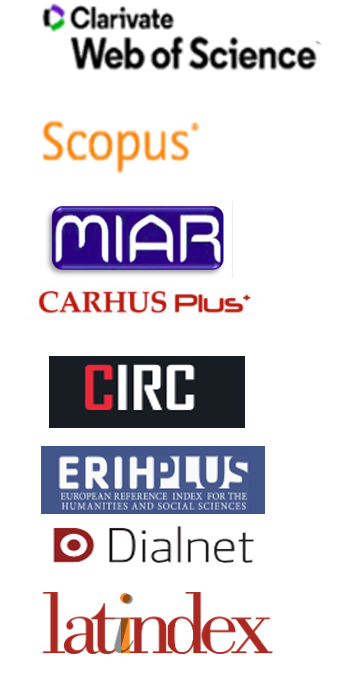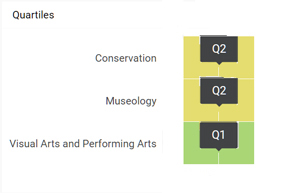Conservation of archaeological copper alloy artifacts from Al Ain National Museum collection: the role of desalination
Abstract
El Museo Nacional de Al Ain se halla en la ciudad de Al Ain en el Emirato de Abu Dhabi (Emiratos Árabes Unidos). Este Museo preserva una importante colección de objetos neolíticos de aleación base cobre procedentes de diferentes yacimientos localizados en las cercanías de la misma ciudad. Durante el proceso de conservación-restauración de las piezas, se notificó la presencia acusada de iones cloro en la mayoría de los objetos procedentes de los ecosistemas áridos cercanos a la costa donde se encontraron.
Este artículo hace hincapié en los procedimientos de desalación realizados durante el proyecto por ser fundamentales para alcanzar la estabilización de los objetos garantizando su preservación por el mayor tiempo posible. El proceso conocido como B70 ha resultado ser efectivo a pesar de no eliminar todas las sales de los objetos, lo que exige un control de los parámetros ambientales para asegurar la salvaguarda de las colecciones.
Downloads
References
ATANASSOVA, V., PENKOVA, P., KOSTADINOV, I., AVDEEV, G. (2019). “Laser removal of chlorine from historical metallic objects”. Proceedings Volume 11047, 20th International Conference and School on Quantum Electronics: Laser Physics and Applications.Event: International Conference and School on Quantum Electronics “Laser Physics and Applications”: ICSQE 2018, 2018, Nessebar. Bulgaria. https://doi.org/10.1117/12.2516813
BERTHOLON R.; RELIER, C. (1990). Les métaux archéologiques. La Conservation en archéologie. Berducou, M. C. Paris, Masson, p. 163-221.
BERTHOLON, R. (2001). “Characterisation and Location of Original Surface of Corroded Metallic Archaeological Objects”. Surface Engineering 17: 240-246.
CANO, E., LAFUENTE, D. (2013): “Corrosion inhibitors for the preservation of metallic heritage artefacts”. Woodhead Publishing. EFC book nº 65, Corrosion and conservation of cultural heritage artefacts.
DÍAZ, S., GARCÍA, E. (2011): Técnicas metodológicas aplicadas a la conservación-restauración del patrimonio metálico. Secretaría General Técnica. Subdirección General de Publicaciones, Información y Documentación. Ministerio de Cultura, Educación y Deporte, España.
DÍAZ, S., GARCÍA, E. (2015): Proyecto COREMANS. Criterios de intervención en materiales metálicos. Ed. Secretaría General Técnica. Subdirección General de Publicaciones, Información y Documentación. Ministerio de Cultura, Educación y Deporte, España.
DILLMANN, P.,BERANGER, G., PICCARDO, P., MATTHIESSEN, H. (2014). Corrosion of Metallic Heritage Artefacts: Investigation, Conservation and Prediction of Long Term Behaviour. Volumen 48 de European Federation of Corrosion (EFC) Series.
FARALDI, F., CORTESE, B., CASCHERA, D., DI CARLO, G., RICCUCCI, C., DE CAROA,T., INGO, G.M. (2017). “Smart conservation methodology for the preservation of copper-based objects against the hazardous corrosion”. Thin Solid Films. Volume 622, 31 January 2017, 130–135. https://doi.org/10.1016/j.tsf.2016.12.024
GANORKAR, M.C., PANDIT RAO, V., GAYATHRI, P., SREENIVASA RAO, T.A. (1988). “A novel method for conservation of copper-based artifacts”. Studies in Conservation 33(2): 97-101. https://doi.org/10.1179/sic.1988.33.2.97
GILBERG, M. (1987). “Friedrich Rathgen: The father of modern archaeological conservation”. Journal of the American Institute for Conservation. Volume 26. https://doi.org/10.1179/019713687806027843
HERRÁEZ, J. A., DE SALAMANCA, G., PASTOR, Mª. J., GIL, T (2014). Manual de seguimiento y análisis de condiciones ambientales. Plan nacional de conservación preventiva. Secretaría General Técnica. Subdirección general de Documentación y Publicaciones. Ministerio de Educación, Cultura y Deporte, España.
JACOT-GUILLARMOD, M., SCHMIDT-OTT, K., MANNES, D., KAESTNER, A., LEHMANN, E., GERVAIS, C. (2019). “Multi-modal tomography to assess dechlorination treatments of iron-based archaeological artifacts”. Heritage Science 7, number 29. https://doi.org/10.1186/s40494-019-0266-x
JOSEPH, E., CARIO, S., SIMON, A., WÖRLE ,M., MAZZEO, R., JUNIER, P., JOB, D. (2012). “Protection of metal artifacts with the formation of metal oxalates complexes by Beauveria bassiana”. Frontiers in Microbiology. Ed. Weiwen Zhang,Tianjin University, China. Volume 2, article 270. https://doi.org/10.3389/fmicb.2011.00270
LIN, H., FRANKEL, G. S. (2013). “Atmospheric corrosion of cu during constant deposition of NaCl”. Journal of The Electrochemical Society, 160(8), C336-C344. https://doi.org/10.1149/2.030311jes
LOGAN, Y. (2007). Recognizing Active Corrosion - Canadian Conservation Institute (CCI) Notes 9/1 part of CCI Notes Series 9 (Metals). Minister of Public Works and Government Services, Canada.
MAGEE, P. (1998). “The chronology and regional context of late prehistoric incised arrowheads in southeastern Arabia”. Arabian Archaeology and Epigraphy, 9(1), 1-12. https://doi.org/10.1111/j.1600-0471.1998.tb00108.x
MARTINEZ, I. (2016). Estudios integrados de procesos analíticos y conservativos de bronce arqueológico. Aplicación a un casco Montefortino y materiales afines. Universitat Politécnica de Valencia.
MUHAMAD, S. A., CHABBI, A. (2013). “Documentation and recording for the conservation of built heritage in Abu Dhabi Emirate”. ISPRS - International Archives of the Photogrammetry, Remote Sensing and Spatial Information Sciences, Volume XL-5/W2, 2013, 437-442. https://doi.org/10.5194/isprsarchives-XL-5-W2-437-2013
OMID, O. (2018). “A methodological approach to estimate soil corrosivity for archaeological copper alloy artefacts”. Heritage Science 6, nº2. https://doi.org/10.1186/s40494-018-0167-4
ORGAN, M. (1977). “The current status of the treatment for corroed metal artifacts”. Corrosion and Metal Artifacts. National Bureau of Standard Publication 479. Washington: 107-142.
PASÍES, T. (2005). “Los trabajos de conservación y restauración del patrimonio metálico”. Boletin del Centro Arqueológico Saguntino. ARSE 39. 57-62.
PATERAKIS, A. B. (1999). “The hidden secrets of copper alloy artifacts in the Athenian Agora”. In Metals 2001: Proceedings of the International Conference on Metals Conservation. 232-236.
POWER, T. (2015). “A First Ceramic Chronology for the Late Islamic Arabian Gulf”. Journal of Islamic Archaeology, 2(1), 1-33. https://doi.org/10.1558/jia.v2i1.27011
RASKOVA, Z., KRCMA, F. (2007). Plasmachemical reduction for the conservation of archaeological artefacts. Publications of the Astronomical Observatory of Belgrade, vol. 82, 159-170.
RODGERS, BA (2004). “Archaeological Copper (Cu) and Copper Alloys”. The Archaeologist’s Manual for Conservation.105-122.
https://doi.org/10.1007/0-306-48613-X_5
SCHMUTZLER, B., EGGERT, G., KUHN-WAWRZINEK, C. F. (2017). “Copper (II) hydroxide on artefacts: Corrosion, conservation, colourants”. Studies in Conservation, 62(2), 61-67. https://doi.org/10.1080/00393630.2016.1215591
SCOTT, D. A. (2002). Copper and bronze in art: corrosion, colorants, conservation. Getty publications.
SCOTT, D. A. (1990). “Bronze disease: a review of some chemical problems and the role of relative humidity”. Journal of the American Institute for Conservation, 29(2), 193-206. https://doi.org/10.1179/019713690806046064
TAIT, W.S. (2012). The role of chloride ions in spray package corrosion. https://www.spraytm.com/the-role-of-chloride-ions-in-spray-package-corrosion.html
YILDIRIM, E., EL MASRI, S. (2010). “Master planning for heritage conservation in Al Ain Oasis”, UAE. In 46th ISOCARP Congress, Nairobi, Kenya. 19-23
- Copyright and intellectual property belongs to author. Author guarantees editing and publishing rights to Ge-Conservación Journal, under a Creative Commons Attribution License. This license allows others to share the work with authorship and the original source of publication acknowledgement.
- Articles can be used for scientific and educational purposes but never for commercial use, being sanctioned by law.
- The whole content of the article is author’s responsibility.
- Ge-Conservación Journal and authors may establish additional agreements for non-exclusive distribution of the work version published at the Journal (for example, on institutional repositories or on a book) with acknowledgment of the original publication on this Journal.
- Author is allowed and encouraged to disseminate his works electronically (for example, on institutional repositories or on its own website) after being published on Ge-Conservación Journal. This will contribute for fruitful interchanges as also for wider and earlier citations of the author’s works.
- Author’s personal data will only be used for the Journal purposes and will not be given to others.









